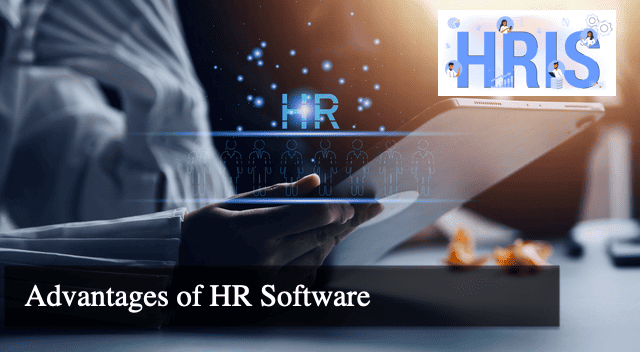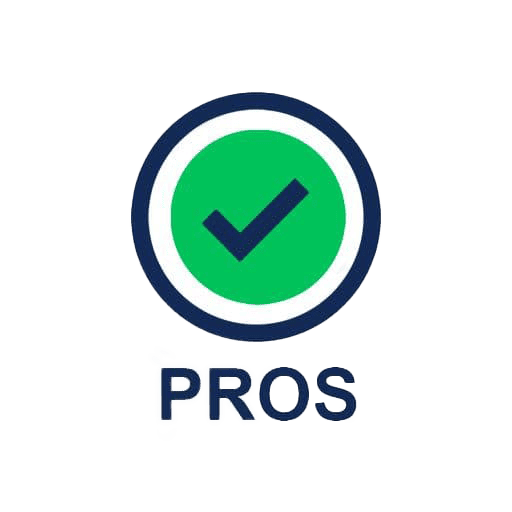
Human Resource Information System (HRIS) software has become a cornerstone for managing human resources. These systems offer a blend of HR and information technology, streamlining employee data management and HR processes. The rise of HRIS marks a significant shift in how businesses approach human resources, transitioning from traditional, manual methods to more efficient, technology-driven processes.
By integrating various HR functions such as payroll, recruitment, and employee management into a single platform, HRIS software simplifies and enhances the HR management experience. Furthermore, adopting HRIS is not just a trend but a strategic move that can substantially improve organizational efficiency, employee engagement, and regulatory compliance.
HR or HRIS Software: 10 Benefits and Advantages

The adoption of HRIS software in an organization brings a multitude of benefits that revolutionize traditional HR practices. By harnessing the power of technology, HRIS systems transform the efficiency, accuracy, and scope of human resource management. Below, we explore the top advantages of integrating HRIS software into your business, showcasing how it can be a game-changer in managing your workforce.
Advantage #1: Enhanced Efficiency in HR Operations
HRIS software dramatically boosts the operational efficiency of HR departments. Automating routine tasks minimizes the time and effort spent on administrative processes, allowing HR professionals to focus on more strategic initiatives. This efficiency streamlines HR workflows and contributes to overall organizational productivity.
- Automation of Routine Tasks: Tasks like timekeeping, payroll processing, and leave management are automated, significantly reducing manual input and the likelihood of errors.
- Reduction in Paperwork: HRIS systems digitize most HR processes, leading to a substantial decrease in physical paperwork, which is time-consuming and prone to loss or damage.
- Faster Processing Times: Employee onboarding, benefits administration, and performance appraisals are expedited, leading to quicker turnaround times and improved employee satisfaction.
Real-Life Example:
A mid-sized retail company implemented an HRIS system and saw a dramatic reduction in the time taken for payroll processing – from several days to just a few hours. This efficiency was echoed in other areas, such as leave management, where employees could apply for leave digitally, and approvals were managed seamlessly through the system. As a result, the HR team was able to redirect their focus towards employee engagement and strategic planning, adding more value to the organization.
Advantage #2: Improved Data Management and Accuracy
The implementation of HRIS software leads to a significant improvement in the management and accuracy of employee data. Centralizing data in one system reduces the risk of discrepancies and ensures information is up-to-date and accessible. This centralized approach is crucial for maintaining the integrity of employee information and making informed HR decisions.
- Centralized Data Repository: All employee information is stored in one place, making it easier to update and retrieve data as needed.
- Reduced Data Redundancy and Errors: Having a single source of truth dramatically minimizes the likelihood of duplicate entries or errors.
- Enhanced Data Security: With advanced security features, HRIS systems protect sensitive employee data against unauthorized access.
Real-Life Example:
A healthcare company faced challenges with inconsistent employee records across different departments. After adopting an HRIS, they centralized all employee data, resulting in uniform and up-to-date records. This change enhanced data accuracy and streamlined compliance reporting, making it easier to adhere to healthcare regulations.
Advantage #3: Better Compliance with Legal Requirements
HRIS software is instrumental in helping organizations adhere to legal and regulatory requirements. By automating compliance-related tasks, HRIS ensures that companies stay up-to-date with changing laws and reduces the risk of non-compliance penalties.
- Automated Legal Updates: HRIS systems often include features that automatically update in response to changes in labor laws and tax regulations.
- Simplified Reporting and Auditing: Generating compliance reports becomes more efficient, aiding in audits and ensuring transparency.
- Effortless Management of Legal Documents: Storing and managing legal employee documents like contracts and tax forms becomes more straightforward and secure.
Real-Life Example:
A multinational corporation used an HRIS to manage its diverse compliance needs across countries. The system’s ability to adapt to various legal environments and automate compliance processes significantly reduced the risk of legal penalties and improved their global HR operations.
Advantage #4: Easier Access to Information
HRIS software provides easy access to HR-related information for both employees and management. This accessibility enhances transparency and empowers employees to manage their HR-related tasks.
- Self-Service Portals: Employees can access their records, apply for leaves, and view their benefits information independently.
- Improved Transparency: Easy access to policies and procedures helps maintain a transparent work culture.
- Mobile Accessibility: Many HRIS solutions offer mobile apps, allowing employees and managers to access information on the go.
Real-Life Example:
A technology firm introduced a mobile-enabled HRIS, allowing employees to access their information and submit requests from anywhere. This flexibility improved employee satisfaction and reduced the administrative burden on the HR department, as employees could handle many queries and tasks themselves.
Advantage #5: Enhanced Decision Making
HRIS software offers robust analytics and reporting tools, providing insights that aid in better decision-making. These tools enable HR professionals and executives to analyze trends, forecast needs, and make data-driven decisions.
- Data-Driven Insights: Access to real-time data and analytics helps understand workforce trends and make informed decisions.
- Customizable Reports: HRIS systems allow customized reports to meet specific organizational needs.
- Strategic Planning Support: The insights gained from HRIS data can be used for strategic planning, such as workforce development and succession planning.
Real-Life Example:
An international sales organization leveraged its HRIS analytics to identify patterns in employee turnover. This insight enabled them to develop targeted retention strategies and training programs, significantly decreasing turnover rates and increasing employee engagement and productivity.
Advantage #6: Streamlined Recruitment Processes
HRIS software significantly streamlines the recruitment process, making it more efficient and effective. From posting job openings to managing candidates and onboarding new hires, HRIS tools facilitate every step of the recruitment journey.
- Efficient Job Posting and Applicant Tracking: Allows for easy posting of job vacancies on multiple platforms and tracking applicants through the recruitment pipeline.
- Automated Candidate Screening: Helps in filtering candidates based on predefined criteria, saving time and effort in the selection process.
- Simplified Onboarding: Streamline hiring process, ensuring a smooth transition for new hires into the organization.
Real-Life Example:
A fast-growing tech startup used HRIS software to automate its recruitment process. This led to a more organized and faster hiring process, allowing them to scale their team efficiently to meet growing business demands. The automated candidate screening and onboarding features also enhanced the candidate experience, positioning the company as an employer of choice.
Advantage #7: Improved Employee Experience
HRIS systems contribute significantly to enhancing the overall employee experience. These systems provide easy access to HR services and enable employees to manage their HR-related tasks, helping create a more engaging and satisfying work environment.
- User-Friendly Interface for Employees: Ensures employees find the system easy and intuitive.
- Empowerment Through Self-Service: Employees control their personal information, benefits management, and leave applications.
- Prompt Response to HR Queries: Reduces the response time for HR-related queries, increasing employee satisfaction.
Real-Life Example:
A hospitality chain implemented an HRIS with a strong focus on user experience. Employees could easily navigate various HR processes, leading to a noticeable increase in engagement and satisfaction. The system’s efficiency in handling queries and requests also positively impacted the company’s employee retention rates.
Advantage #8: Strategic HR Management
HRIS enables organizations to take a strategic approach to HR management. With comprehensive data and analytics, HR leaders can make decisions that align with business objectives and drive organizational success.
- Alignment with Organizational Goals: Ensures HR processes and strategies align with the business objectives.
- Workforce Planning and Talent Management: Facilitates effective planning for current and future talent needs.
- Succession Planning Capabilities: Helps identify and develop future leaders within the organization.
Real-Life Example:
An international manufacturing firm used its HRIS for strategic workforce planning. By analyzing workforce data, they could anticipate skill gaps and plan for future hiring needs. This proactive approach helped the company maintain a competitive edge in a rapidly changing industry.
Advantage #9: Cost Savings
Implementing an HRIS can lead to significant cost savings for an organization. By automating HR processes and reducing the need for manual work, businesses can cut down on labor costs and minimize errors that could be costly.
- Reduction in Manual Work and Associated Costs: Automating HR tasks reduces the need for extensive manual labor and related expenses.
- Minimizing Errors and Associated Risks: Reduces the likelihood of costly mistakes in areas such as payroll and compliance.
- Efficient Resource Allocation: Allows for more strategic allocation of HR resources, optimizing the department’s budget.
Real-Life Example:
A retail chain experienced reduced HR operational costs after adopting an HRIS. Automating payroll and timekeeping processes minimized errors and reduced the need for additional staffing in these areas. This cost efficiency was reinvested into employee development programs, benefiting the organization.
Advantage #10: Scalability for Growing Businesses
HRIS systems are designed to scale with the growing needs of a business. This scalability ensures that its HR system can adapt as a business expands to accommodate new employees, additional locations, and evolving business requirements.
- Adaptable to Business Growth: Easily handles increasing employees and expanded operations.
- Flexibility to Integrate with Other Systems: Can be integrated with other business systems as the company grows and its needs change.
- Support for Global Operations: Capable of managing HR operations across different regions and complying with various legal requirements.
Real-Life Example:
A rapidly expanding e-commerce company utilized an HRIS that scaled with its growth. As they entered new markets and hired more staff, the HRIS adapted seamlessly, managing different languages, currencies, and legal requirements without disrupting their HR operations. This adaptability was crucial in supporting the company’s ambitious growth trajectory.
Conclusion
Integrating HRIS software in an organization is more than just a technological upgrade; it’s a strategic transformation of the HR function. The advantages of HRIS, ranging from enhanced efficiency and improved data management to strategic HR management and scalability, demonstrate its indispensable role in modern business operations. By automating routine tasks, providing valuable insights through data analysis, and ensuring compliance with legal standards, HRIS systems empower organizations to focus on growth and innovation. They streamline HR processes and contribute significantly to a business’s overall health and success, making them a critical investment in today’s competitive landscape.
Furthermore, the impact of HRIS extends beyond operational efficiencies to profoundly influence the employee experience and organizational culture. By providing user-friendly, accessible, and efficient HR services, these systems foster a more engaged and satisfied workforce. This shift in how businesses manage their most valuable asset – their people – reflects a deeper understanding of the role of HR in achieving business success. As technology continues to evolve, HRIS systems will undoubtedly become more sophisticated, further revolutionizing the way organizations manage their human resources and driving them toward a future of greater efficiency, compliance, and strategic growth.
Daniel Raymond, a project manager with over 20 years of experience, is the former CEO of a successful software company called Websystems. With a strong background in managing complex projects, he applied his expertise to develop AceProject.com and Bridge24.com, innovative project management tools designed to streamline processes and improve productivity. Throughout his career, Daniel has consistently demonstrated a commitment to excellence and a passion for empowering teams to achieve their goals.